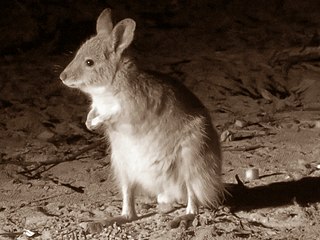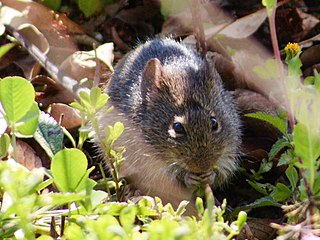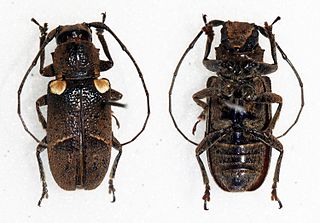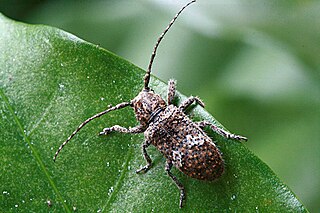
The rufous-breasted hermit or hairy hermit is a hummingbird that breeds from Panama south to Bolivia, and on Trinidad, Tobago and Grenada. It is a widespread and generally common species, though local populations may change in numbers and disappear altogether in marginal habitat.

The spotted handfish is a rare Australian fish in the handfish family, Brachionichthyidae, classified as critically endangered on the IUCN Red List 2020. It has a highly restricted range, being found only in the estuary of Derwent River, Tasmania, and nearby areas, with the main threat to its existence being an invasive species, the Northern Pacific seastar.

The first Waldgraves or Wildgraves descended from a division of the House of the Counts of Nahegau in the year 1113.

The rufous hare-wallaby, also known as the mala, is a small macropod found in Australia. It was formerly widely distributed across the western half of the continent, but naturally occurring populations are now confined to Bernier Island and Dorre Island Islands off Western Australia.
The hairy harvest mouse is a species of rodent in the family Cricetidae found only in Mexico.

The hairy fruit-eating bat is a species of bat in the family Phyllostomidae. It is endemic to Mexico.

The Honduran fruit-eating bat is a species of bat in the family Phyllostomidae. It is found in El Salvador, Honduras, and Nicaragua.

Lathyrus hirsutus is a species of wild pea known by several common names, including Caley pea, singletary pea, hairy vetchling, and Austrian winter pea. It is native to Europe, North Africa, and much of Asia, and it is known from other continents, including North America, as an introduced species. This is an annual herb producing a winged stem and leaves each made up of two leaflike leaflets with a branching, coiled tendril. The inflorescence holds one or two pink, blue, or bicolored pea flowers each 1 to 1.5 centimeters wide. The fruit is a dehiscent legume pod covered in hairs with each hair growing from a minute bulbous base. The rest of the plant is generally hairless.

The southern cotton rat is a rodent species in the family Cricetidae. It is found from southern Chiapas in Mexico through Central America, except for Belize, and as far east as northern Colombia and Venezuela. It lives in tropical rainforest, dry forest and savanna, as well as in cultivated areas. The species is terrestrial and primarily diurnal. It was long thought to be a subspecies of S. hispidus. However, recent taxonomic revisions, based on mitochondrial DNA sequence data, have split the extensive former species range into three separate species. Carroll et al. (2004) indicate that the southern edge of the S. hispidus distribution is likely near the Rio Grande where it meets the northern distribution of S. toltecus. The range of S. toltecus extends from northern Mexico south into Chiapas where it occurs in sympatry with S. hirsutus . Rats from this species group have been used as laboratory animals.

Artocarpus hirsutus, commonly known as wild jack, is a tropical evergreen tree species that is native to India, primarily in Kerala, but also in Karnataka, Maharashtra and Tamil Nadu, where it grows in moist, deciduous to partially evergreen woodlands.

Luteolin-7-O-glucuronide is a chemical compound that is classified as a flavone.

Cytisus hirsutus is a perennial plant belonging to the genus Cytisus of the family Fabaceae.

Prosoplus is a genus of longhorn beetles of the subfamily Lamiinae, containing the following species:

Helianthus hirsutus is a North American species of sunflower known by the common name hairy sunflower. It is widespread across south-central Canada, the eastern and central United States, and northeastern Mexico. It ranges from Ontario south to Florida, Coahuila, and Nuevo León, and west as far as Minnesota, Nebraska, and Texas.
Prosoplus atlanticus is a species of beetle in the family Cerambycidae. It was described by Stephan von Breuning in 1938.

Rhytiphora bankii is a species of beetle in the family Cerambycidae. It was first described by Johan Christian Fabricius in 1775, under the genus Lamia. It is known from Australia, the Philippines, Borneo, Java, Micronesia, New Guinea, Hawaii, Moluccas, Sumatra, Vietnam, and has been introduced into Japan. The Australian species of Prosoplus were synonymised with Rhytiphora in 2013.
Prosoplus costatus is a species of beetle in the family Cerambycidae. It was described by Karl-Ernst Hüdepohl in 1996. It is known from Borneo and Malaysia.
Prosoplus dentatus is a species of beetle in the family Cerambycidae. It was described by Guillaume-Antoine Olivier in 1792. It is known from Mauritius, Seychelles, Réunion, and Madagascar. It contains the varietas Prosoplus dentatus var. ochreomaculatus.
Prosoplus lividus is a species of beetle in the family Cerambycidae. It was described by Masaki Matsushita in 1935.
Prosoplus sinuatofasciatus is a species of beetle in the family Cerambycidae. It was described by Blanchard in 1855.













